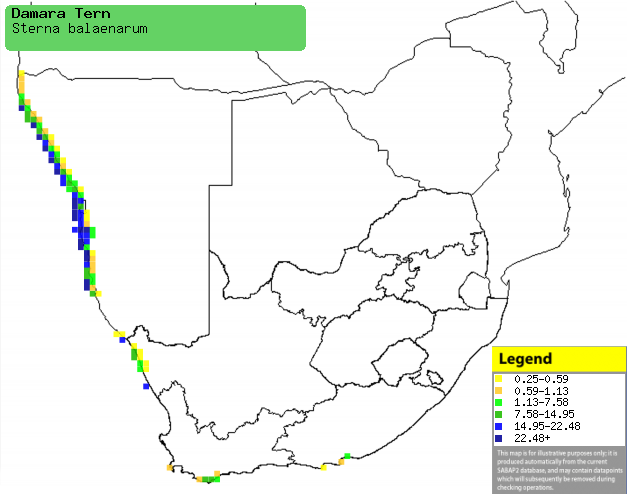|
Sterna balaenarum (Damara
tern)
Damarasterretjie [Afrikaans]; Damara-stern [Dutch];
Sterne des baleiniers [French]; Damaraseeschwalbe [German]; Gaivina de
Damara [Portuguese]
Life
> Eukaryotes >
Opisthokonta
> Metazoa (animals) >
Bilateria >
Deuterostomia > Chordata >
Craniata > Vertebrata (vertebrates) > Gnathostomata (jawed
vertebrates) > Teleostomi (teleost fish) > Osteichthyes (bony fish) > Class:
Sarcopterygii (lobe-finned
fish) > Stegocephalia (terrestrial
vertebrates) > Tetrapoda
(four-legged vertebrates) > Reptiliomorpha > Amniota >
Reptilia (reptiles) >
Romeriida > Diapsida > Archosauromorpha > Archosauria >
Dinosauria
(dinosaurs) > Saurischia > Theropoda (bipedal predatory dinosaurs) >
Coelurosauria > Maniraptora > Aves
(birds) > Order: Charadriiformes
> Family: Laridae > Genus: Sterna
Distribution and habitat
Occurs along the western coast of Africa; within southern
Africa it is locally common along the coast of
Namibia and the Northern Cape, while scarce further south. It generally prefers
arid desert shores, especially with sheltered bays and reefs, while it mainly
breeds on gravel plains between dunes and on salt pans.
|
 |
|
Distribution of Damara tern in southern Africa,
based on statistical smoothing of the records from first SA Bird Atlas
Project (©
Animal Demography unit, University of
Cape Town; smoothing by Birgit Erni and Francesca Little). Colours range
from dark blue (most common) through to yellow (least common).
See here for the latest distribution
from the SABAP2. |
Predators and parasites
- Predators of eggs and chicks
Movements and migrations
Mainly an intra-African breeding migrant,
breeding in southern Africa before heading north to the west African
coast in the non-breeding season.
Food
Mainly eats fish and aquatic invertebrates, doing most of
its foraging over shallow water, repeatedly plunge-diving from 3-8 metres up. The following food items have been recorded
in its diet:
- Fish
- Tylosaurus (needle fish)
- Mugil (small mullet)
- Engraulis encrasicolus
- larval blennies (Blennidae)
- Aquatic invertebrates
Breeding
- Monogamous, either nesting solitarily or in loose colonies, performing a
courtship display in which the male brings fish to the female.
- The nest is a shallow scrap in gravel or a hard salt pan, sometimes
sparsely lined with shell chips or small stones and typically placed in an
elevated position adjacent to a large stone, tyre, ostrich track or piece of
driftwood.
- Egg-laying season is from October-June, peaking from October-December.
- It lays a single egg, which is incubated by both sexes for 17-30,
usually 18-22 days.
- The chick is mainly brooded by the female while the male provides the
food, leaving the nest after about two days then slowly travelling towards
the sea. It learns to fly at about 20 days old, at which point juveniles
form
flocks on the beach. It is still dependent on its parents for approximately
ten more weeks.
Threats
Previously considered Endangered in Namibia, it is
now thought to be Near-threatened there, as its population is now somewhat
stable. However it is still Endangered in South Africa, where
disturbance and urbanisation have already resulted in the loss of two colonies.
References
-
Hockey PAR, Dean WRJ and Ryan PG 2005. Roberts
- Birds of southern Africa, VIIth ed. The Trustees of the John Voelcker
Bird Book Fund, Cape Town.
|
